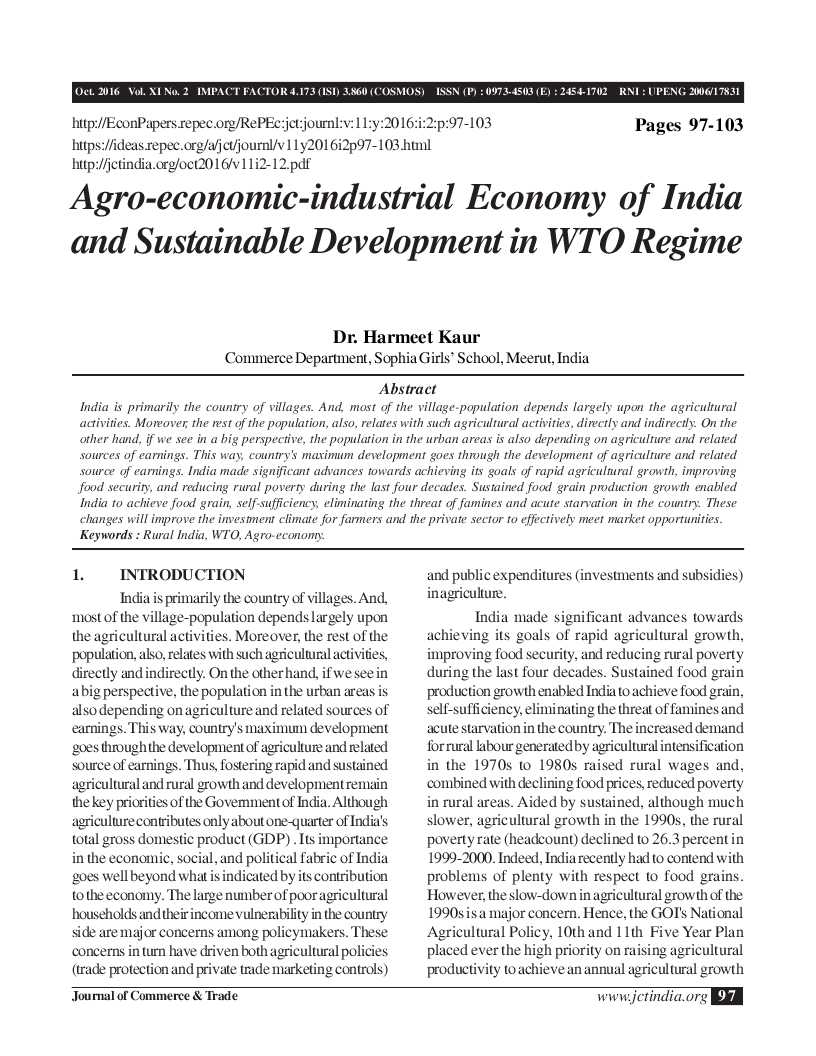Agro-economic-industrial Economy of India and Sustainable Development in WTO Regime
DOI:
https://doi.org/10.26703/jct.v11i2.219Keywords:
Rural India, WTO, Agro Economy, JCTAbstract
India is primarily the country of villages. And, most of the village-population depends largely upon the agricultural activities. Moreover, the rest of the population, also, relates with such agricultural activities, directly and indirectly. On the other hand, if we see in a big perspective, the population in the urban areas is also depending on agriculture and related sources of earnings. This way, country's maximum development goes through the development of agriculture and related source of earnings. India made significant advances towards achieving its goals of rapid agricultural growth, improving food security, and reducing rural poverty during the last four decades. Sustained food grain production growth enabled India to achieve food grain, self-sufficiency, eliminating the threat of famines and acute starvation in the country. These changes will improve the investment climate for farmers and the private sector to effectively meet market opportunities.
Downloads
References
Ishwar C. Dingra (1995), "The Indian Economy", Sultan Chand and Sons, New Delhi, p. 165.
Mishra and Puri (2005), "Indian Economy", Himalaya Publishing House, New Delhi, p. 132.
Keayla B.K (2002), "WTO and India", Swadesh Jagran Prakashan, New Delhi, p. 14.
Sinha P.N (1973), "Scope for Agro-Based Industries", Commerce, Vol. 127, Nov. 17, p.28.
Gulati, Ashok et. al. (1999), "From Marrakesh to SEATTLE - Indian Agriculture in Globalizing World", Economic and Political Weekly, Vol.XXXIV, October, p. 12.
Centre for Economic and Social Studies, "Rural Employment, Diversification and Pro-Poor Growth in India." Hyderabad, Andhra Pradesh. 2002.
Federation of Indian Chambers of Commerce and Industry (FICCI). "Indian Agriculture Unbound: Making Indian Agriculture Globally Competitive." 75 Platinum Jubilee Series Policy Paper, New Delhi, 2002.
Kapila R., and U. Kapila, "Indian Agriculture in the Changing Environment", Vol. 1 and 2, Academic Foundation, New Delhi.
GOI, Ministry of Agriculture, Directorate of Economics and Statistics, "Agricultural Statistics at a Glance", New Delhi, 2003
Pal, S., and D. Byerlee. "The Funding and Organization of Agricultural Research in India: Evolution and Emerging Policy Issues." National Centre for Agricultural Economics and Policy Research, ICAR, New Delhi, 2003.
Ramaswami, B. "Efficiency and Equity of Food Market Interventions." Economic and Political weekly xxxvii (12), 2002.
Sharma, A. "The Agricultural Sector: In Economic and Policy Reforms in India", National Council of Applied Economic Research, pp.185-213, 2002.
Sulaiman, R., and V.V. Sadamate, "Privatizing Agricultural Extension in India", Policy Paper 10, New Delhi: National Centre for Agricultural Economics and Policy Research, 2000.
India Policies to Reduce Poverty and Accelerate Sustainable Development. Report No. 19471-IN. South Asia Poverty and Economic Management Sector Unit, January 31, 2000.
Economic Survey of India 2004 -05, New Delhi 2005 - 2006.
Agricultural business survey 2005, 2006.
The Hindu Survey of Indian Agriculture, 2005.
Yojna, August 2006 & September 2006.
Kurukshetra, August 2006 & September 2006.
The Economic Times, Bombay.
GOI, Publication Division, INDIA, 2006.
Webliography

Downloads
Published
Issue
Section
License
Copyright (c) 2016 Dr. Harmeet Kaur

This work is licensed under a Creative Commons Attribution 4.0 International License.










